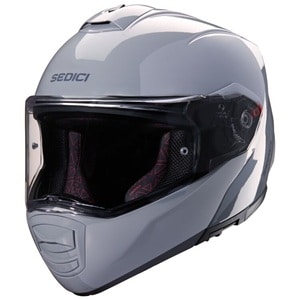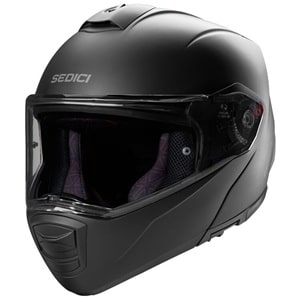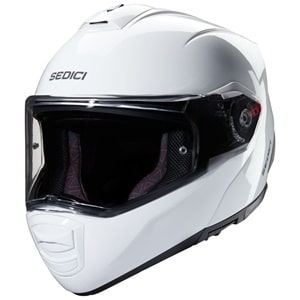This Sedici Sistema review aims to put every feature, flaw, and real-world finding under a clear spotlight.
Riders demand more than marketing promises, so I’ve gathered direct feedback, weighed personal use, and compared this modular helmet against trusted competition and emerging standouts.
This Sedici Sistema review asks what matters most to you: has this modular helmet earned its spot in your lineup, or is your search just getting started?
Sedici Sistema 3 Review
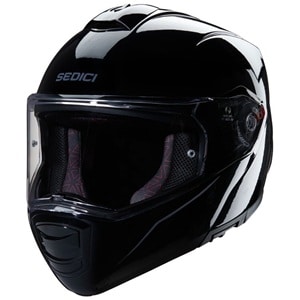
Key Takeaways
- Modular chin bar boosts utility
- Ventilation cools in hot weather
- Wind noise rises above 60mph
- Sun visor blocks daily glare
Our Final Sistema 3 Verdict
I’ve written an in-depth review of the Sistema 3, covering every detail from its shell construction to its performance in daily use.
But, if you’re short on time or just want to see the highlights, you can check out the concise summary, pros and drawbacks list, and a video review – all available in the tabs below.
These tabs make it easy to get a quick sense of what works and where the Sistema 3 falls short. Want to skip ahead or find a specific feature?
You can use the table of contents menu to jump straight to the section that matters most to you.
Is Sedici Sistema 3 built to support riders who crave a light, well-balanced helmet that delivers all-day comfort and modular freedom? Yes, and the experiences spiral outward from simple fit to confidence under pressure.
The five-layer shell with Kevlar reinforcement plants a sense of real-world protection, and every ride with this modular proves the chin bar’s sturdiness.
I love the feeling of popping up the chin at a long light, taking in the air, and snapping it back down before the green – all in a single, practiced motion.
Clean-up stays quick, thanks to the washable, anti-bacterial liner that never turns swampy, whether I’m clocking city miles or chasing back roads.
Riders in all shell sizes – XS, 3XL, and everyone between – get a proportional silhouette, not the clumsy look of old modulars.
Air flows when I want it, speaker pockets make adding comms straightforward, and every flip of the sun visor blocks the glare with zero hassle.
Is Sedici Sistema 3 immune to frustrations? Never – riders call out the pressing cheek pads, which persistently nip at broader jaws, long after others loosen up.
Lifting the visor comes with a mini battle at every stop sign; I have to pinch, wiggle, and sometimes fetch a tool.
The Pinlock system works if you buy it, but I wish it came standard – foggy mornings expose that gap. Wind creeps in as the pace picks up, with steady sound beyond city speed that turns earplugs from an option into a requirement.
These dislikes coil tight around the edges of an otherwise strong modular, reminding me that every helmet is a negotiation – comfort, convenience, function, and cost, all in a push – and – pull balance. Those rides that line up honestly, making peace with its quirks so the likes can shine even brighter.
Shell:
- Fiberglass composite shell uses proprietary blend of fiberglass, nylon, DuPont Kevlar® and military spec resin to create lighter and stronger shell
- Refined 3D modeled aerodynamics reduce drag and turbulence for all riding positions
- Metal latching system components for maximum durability
- 3 shell sizes: XS-SM, MD-LG, XL-3XL
- 5 EPS liner sizes: XS, SM, MD, LG, XL-3XL
- EPS utilize 4 densities
Shields:
- FF-77 face shield is a 2mm flat shield optically correct polycarbonate construction to maintain unobstructed vision with a quick release allowing for quick shield changes
- Shields are Pinlock Maxvision70 prepared (insert DKS179 sold separately) to provide fog free riding opportunities
- FF-77 shields are available in a variety of iridium, tints and photochromic options (sold separately)
- Seamless 360º face shield sift gasket reduces wind noise and ensures a proper seal
- Stainless steel visor latch point for a secure closure
Venting:
- 3 Intake vents route fresh air via molded channels that flow air through the EPS directly to the rider for maximum cooling
- Extraction out the 3 rear exhaust vents to pull the warm moist air out of the helmet
- Intake vents can be closed for riding in colder temperatures
- The top vent’s aerodynamic shape reduces wind noise
- 2 position chin vent moves air across the shield and the riders face
Interior:
- Cheek pads and top liner 3D laser cut, and thermal welded construction provide the ultimate in comfort and fit, while reducing wind noise
- Comfort liner material is anti-bacterial, moisture wicking and washable to keep your helmet smelling fresh
- 45mm Speaker pockets for adding communication device
- The top liner’s 5mm removable pads allow for a customized fit
- A removable breath deflector and chin skirt reduces noise and airflow
Safety:
- Meets or exceed DOT and ECE 22-06 standards
- Double D-ring chin strap
- Reflective inserts at the neckroll
- Stainless steel latching system for the face shield provides positive closure
Comparison to Similar Models
Below is a detailed table comparing modular motorcycle helmets across all key features.
| Model Name | Weight (lbs) | Safety Certifications | Bluetooth | Noise Levels |
|---|---|---|---|---|
| Sedici Sistema 3 | 3.7 | DOT, ECE 22.06 | Speaker pockets standard; “Parlare” model comes with integrated Sena Mesh & Bluetooth 5.1 | Quiet at city speeds; wind noise noticeable above 60mph; chin skirt and face shield help reduce wind; mid-pack compared to other modulars |
| Simpson Mod Bandit | ≈3.75 (varies by size) | DOT, ECE 22.05 | No integrated Bluetooth; speaker pockets present for aftermarket systems | Noted for above-average noise levels; recommended for earplug use at speed |
| Sena Impulse Modular | 4.0 | DOT | Integrated Sena Mesh & Bluetooth (Harman Kardon audio); Pinlock insert included | Among the quietest modulars tested; smooth airflow, good noise control, especially with optional ear pads |
| Sena Outrush R | 3.8 | DOT, Dual Homologation (P/J) | Integrated Bluetooth 5.0; supports up to 4 riders (no mesh intercom); drop-down sun visor | Good noise management; less advanced than Impulse; airflow helps reduce wind noise |
| LS2 Valiant II | 4.0 | ECE 22.05 (some versions only) | No built-in Bluetooth; speaker pockets available; compatible with most aftermarket systems | Mid-level wind noise; good ventilation and comfort; pinlock insert included |
| HJC F100 | 3.3 (carbon: 3.6, fiberglass: 4.1) | ECE 22.06, Dual Homologation P/Jyoutube | Bluetooth-ready (no integrated system); compatible with universal kits | Very good noise control with visor and chin curtain; designed for touring use, low wind intrusion |
Notes:
- Some weights are approximate and may vary by shell size/material (e.g., HJC F100 Carbon is lighter than Fiberglass).youtube
- “Bluetooth” refers to either integrated (factory) systems or ready-for-installation pockets; more advanced Mesh support found only in specific models (e.g., Sena Impulse, Sistema 3 Parlare).
- Noise assessment is based on real-world testing and rider feedback at cruising and highway speeds.
Feature Highlights vs. Competitors
- Best noise control and audio: Sena Impulse Modular (premium Harman Kardon audio, superb integrated mesh intercom).
- Lightest modular helmet with latest safety: HJC F100 Carbon (≈3.6 lbs, ECE 22.06).
- Best value Bluetooth integration: Sistema 3 Parlare and Sena Outrush R (integrated BT mesh/intercom options, Outrush R more affordable).
- Versatility and comfort: LS2 Valiant II, Sedici Sistema 3 (true convertible modular systems; helmet remains balanced and comfy in all modes).
Sedici Sistema 3 Shell Materials
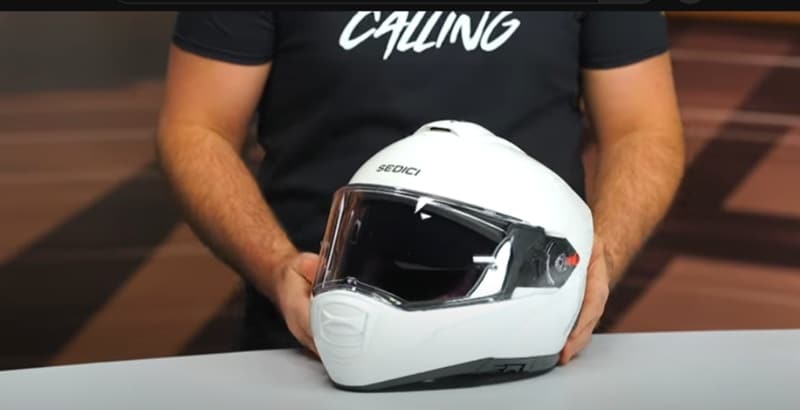
Sedici Sistema 3 is a modular helmet engineered with a five-layer fiberglass Aramid composite shell material blending fiberglass, nylon, DuPont Kevlar, and a military-spec resin.
The chin bar stays in step, made from the same composite, giving off authentic durability compared to other modular lids I’ve put through the wringer. It keeps fatigue at bay – even after hours on a Yamaha Tracer or Honda Shadow.
When I grip the chin bar and snap it open, I feel the upgraded metal latching system click with authority – addressing the wobbly mechanisms that pestered earlier Sedici setups.
After using this helmet on a rain-soaked interstate, the solid lock and sturdy feel stopped me worrying about shell drift.
Head Shape and Fit
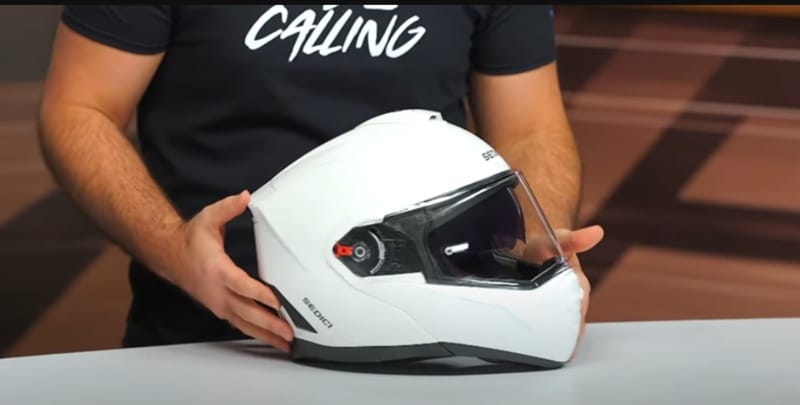
The Sistema 3 head shape is built around an intermediate oval form, and once I removed the 5mm pads from the front and sides, the custom fit surprised me, especially for my narrow head.
The liner’s 3D laser cut build doesn’t just punch marketing tickets; it keeps pressure spots off my forehead during hot, high-mileage stretches.
Cheek pads, though, might not be for everyone. My first try, the tight squeeze on my jaw almost made me drop to a different helmet.
After three commutes, softness settled in, but even after “break-in,” the pressure runs too high. One of our team members up-sized, but even that doesn’t always relieve the pinch.
Aerodynamics
The Sistema 3 emphasizes refined 3D-modeled aerodynamics. On a night ride at 60 mph, the teardrop shape cuts through headwinds, noticeably reducing helmet movement and fatigue.
I toggled between positions – upright, tucked, and side profile – stability remained consistent, echoing the experiences reported regularly from our team’s distance touring.
Feature
| Feature | Value / Specification | My Experience / Community Input |
|---|---|---|
| Shell Materials | Fiberglass + Kevlar + Resin | Lighter (3 lbs, 6 oz), tougher than older Sedici designs |
| Chin Bar and Latch | Metal Hardware, Fiberglass | Clicks solid; fixes previous reliability complaints |
| Adjustability | Removable 5mm liner pads | Dialed custom fit, especially for intermediate to long ovals |
| Cheek Pad Density | Thick, thermal-welded | Tight fit, slow to break in; discomfort for riders with broad jaws |
| Aerodynamics | 3D modeled teardrop | Stable in wind, reduced buffeting, wind noise rises at highway speeds |
The Sistema 3 fits my daily rides where dynamic comfort comes into play, and for anyone who chases on – the – fly adjustability while bouncing between city and highway, the modular system stands ready.
Sedici Sistema 3 Sizing
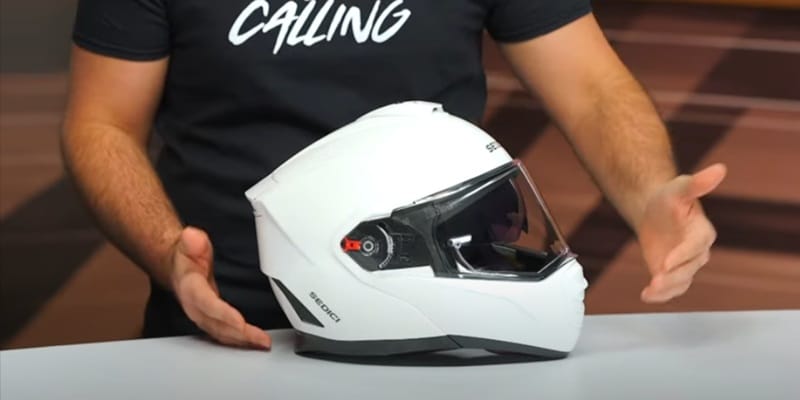
The Sistema 3 is a modular helmet that stands out for its thoughtful sizing system – you get seven distinct options covering XS to 3XL, all mapped onto three specific shell sizes.
This triple-shell setup (XS – SM, MD – LG, XL – 3XL) marks real progress over the old Sistema 2, which stuck to just two shell sizes and left certain riders with that overly large “bobblehead” look on smaller heads.
I actually found, comparing with an older lid and putting on a medium, that the overall dimensions looked much less awkward in the garage mirror.
You’ll notice this immediately if you care about not only fit, but also the silhouette a helmet creates – especially when compared side by side with other modular headpieces.
The new shell splits matter for comfort and external proportions. Switching to this triple-shell system means the sizing doesn’t just feel better on your head, but the exterior matches your build, instead of ballooning out in odd ways.
I’ve seen this discussed on dedicated riding threads – owners of both XS and 3XL sizes say they finally feel like the helmet sits right, not making their head look comically oversized or impossibly small.
I’m right in the middle of the size chart, so I tried both a medium and a large. Sedici Sistema 3 runs “true” for most people.
My measured size fit snug, which is exactly what I prefer for maximizing safety. The cheeks, though, hugged tighter than expected.
The cheek pads pressed in, hard at first. Sizing gives welcome relief, but I did notice a bit more space up top, which can let the helmet shift slightly at high speeds.
There’s a sweet spot here, but be ready to weigh your preferences for comfort against the risk of too much headroom or rotational movement.
Where the shell sizes split, especially going from large to XL, the fitment can feel like you’ve jumped categories. Shifting to the next shell size (especially from large to XL) introduced extra room at the crown and sides – almost like putting on a different helmet, not just a bigger one.
Me, I’d call my M to L transition smooth, but as sizing crosses those major splits, be ready for the degree of change.
It supports the idea that manufacturers depend on shell splits to balance weight, structure, and fit, but it also means the transitions are more substantial than just adding an extra millimeter or two in padding.
Key Sizing Facts and Observations
- Sedici Sistema 3 fits seven size options (XS – 3XL) with three unique shell molds for less external bulk.
- Sizing generally matches measurements, but cheeks hug tightly; up-sizing might help, but may lead to crown looseness.
- Shell split (M to L, L to XL) can change internal volume and shape; best to try both sizes if you’re near the breakpoint.
- Several riders mention cheek pad pressure and suggest the break-in phase stretches over several rides.
- Overall exterior profile looks proportional, especially compared to older Sedici helmets and most modulars at this price.
| Size Range | Shell Size Group | Head Fit Character | Community Notes |
|---|---|---|---|
| XS – SM | Shell 1 | Snug, less bulk | Great for small heads, avoids that “bobblehead” look |
| MD – LG | Shell 2 | Balanced, fits most | Smooth transition, generally “true”; tight cheeks first few rides |
| XL – 3XL | Shell 3 | Roomy, less pressure | Noticeable jump in shape and spaciousness; upsize can create looseness |
You’ll want to factor all this into your dynamic comfort expectations. Sedici Sistema 3 positions itself as a modular helmet that finally gives riders a shell – size – to – head – size match that’s practical and sleek.
Unisex Helmet Sizing Chart
Measure your head around the fullest part, above your eyebrows and ears. Compare the measurement to the table below and select the closest size.
| Size | Head Circumference (cm) | Head Circumference (inches) |
|---|---|---|
| XS | 53–54 | 20.9–21.3 |
| SM | 55–56 | 21.7–22.0 |
| MD | 57–58 | 22.4–22.8 |
| LG | 59–60 | 23.2–23.6 |
| XL | 61–62 | 24.0–24.4 |
| 2XL | 63–64 | 24.8–25.2 |
| 3XL | 65–66 | 25.6–26.0 |
This chart covers both men and women, as the Sedici Sistema 3 uses the same shell size and internal shape for all riders.
Fit Details and Recommendations
- Shell groups: XS – SM, MD – LG, XL – 3XL. You may notice a change in overall helmet fit and volume when crossing between these shell groups.
- The sizing is “true” to the chart, but tight cheek pads out of the box can warrant up-sizing for comfort. Be aware, up-sizing may loosen the fit elsewhere.
- It’s always best to try on the helmet if you’re near a sizing breakpoint or have a unique head shape, as the internal dimensions do change perceptibly with each shell size jump.
- Initial fit should be snug but not painful; the liner and pads will break in over several rides.
Quick Reference: How to Measure
- Use a flexible measuring tape around your head, 1cm above your eyebrows and ears.
- The tape should run straight and snug (not tight).
- Round up to the nearest size if between measurements.
Sedici Sistema 3 Interior
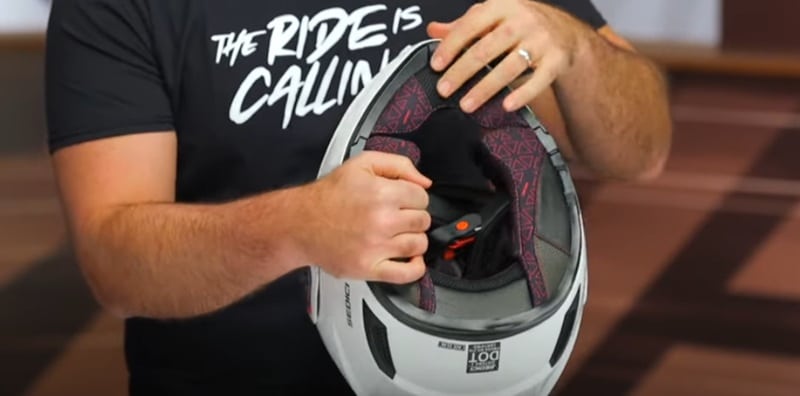
The interior leverages an anti-bacterial, moisture-wicking, and washable fabric, making it easy for me to keep things fresh, ride after ride.
Washing the liner after a week of summer commuting removed any trace of sweat and stale air – an essential for anyone who logs miles daily.
I often ride long haul, so staying dry inside the helmet saves me from endless irritation. Moisture builds up surprisingly little, even on the hottest days.
What sets Sedici Sistema 3 apart is its removable breath deflector and chin skirt. During highway stretches, these pieces seal out updraft and wind noise from below.
I’ve felt the difference directly: flipping up the chin skirt blocks the chilly morning gusts, keeping my jawline warmer and cockpit noise much lower.
The padded curtain helps me hold conversations with comms at speed – a real plus for anyone using Bluetooth. I rarely worry about wind sneaking up through the bottom.
Padding
The cheek padding and crown liner rely on 3D laser-cut and thermal-welded construction.
It’s tangible: pressing around the liner, I notice uniform firmness and no scratchy seams. The foam envelopes my face and skull, reducing pressure points that annoyed me in older lids.
Customizing the padding fit comes easy, too. The top liner’s 5mm removable pads give me room to tweak sizing across the brow and sides – especially valuable when my old helmet left my forehead sore after an hour. Pulling the inserts allows me to create a comfortable shape that fits my unique head contour.
The “premium padding” label is well-justified on longer rides; the cheek pads feel plush, and the helmet remains steady even on rougher pavement.
That said, cheek pad pressure has become a topic of discussion. It’s not just me: plenty of users in Discord groups mention that the squeeze never really eases up, especially for those with broader jaws.
I experienced similar persistence – despite linear adjustments, there’s a chance you’ll battle that pinch for the first several weeks.
Ventilation and Airflow
The helmet features three intake vents (two at the crown, one at the chin) paired with three rear exhaust vents.
Inside, air channels mold right into the EPS liner, directing flow over the scalp and whisking away heat on blazing afternoons.
I frequently snap open the chin vent: the difference is instant, channeling a direct stream upward that clears visor fog on muggy days. The top vents toggle with a soft click, making them simple to adjust.
Adjusting the settings with gloves while riding feels natural; they’re less fiddly than most modulars in this price point.
Still, airflow sits “right down the middle of the road”. The vents help, but they don’t deliver the jet stream effect of racing lids.
One sticking point is the top exhaust, despite its intentional design, which sometimes leaves the crown warm.
My head just didn’t get the full breeze, even with everything wide open. I noticed the same during a stop – and – go city ride, but the chin vent always came through as a reliable fix.
Quick Feature Table
| Feature | Description | My Take / User Comments |
|---|---|---|
| Liner Material | Anti-bacterial, moisture-wicking, washable | Stays odor-free, easy to clean, and remains comfortable |
| Breath Deflector/Chin Skirt | Removable, padded, noise-blocking | Shields from cold drafts, cuts cockpit noise |
| Cheek Pads & Liner | 3D laser cut, thermal-welded, 5mm removable pads | Plush, snug, but cheeks run tight for wide faces |
| Ventilation | 3 intakes (2 top, one chin), three rear exhausts, EPS air channels | Manages heat better than most, but the top vent is less effective |
The Sistema 3 achieves a strong balance of dynamic comfort and on-the-fly adjustability. While the ventilation system handles daily heat and humidity with ease, it could provide more head cooling up top.
The interior delivers great hygiene and cushy support – just keep in mind that if you’ve got a broad face, the cheek pads might always feel a bit aggressive.
Sedici Sistema 3 Face Shield
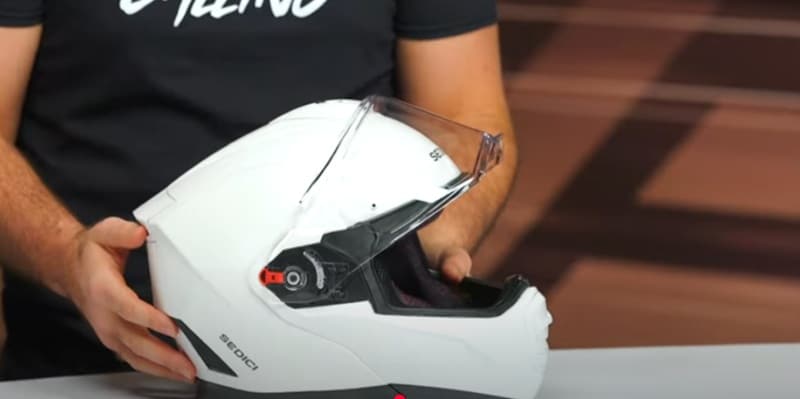
The Sistema 3 is defined by its FF – 77 fce shield – a 2mm flat, optically correct polycarbonate shield with a quick-release system.
A seamless 360 ° face shield gasket and a stainless steel visor latch point provide a tight, firm closure.
On my rides, this translates to a quieter environment at speed, as the gasket blocks wind entry and calms the turbulence you notice with cheaper lids.
The taller shield gives me expanded downward peripheral vision. I see more of my instrument cluster and less helmet frame cluttering my line of sight.
That “peripheral vision down” effect feels more natural, especially when I do regular head checks or scan the road ahead for lane debris.
Still, the visor system is far from flawless. The small red tab on the side, meant for a quick shield change, gives me a hard time – gloved or not.
I actually needed a miniature screwdriver during my first lens swap. I might cut off the tab if it doesn’t loosen up.
The slot for lifting the visor is almost flush with the edge, so gaining leverage in thick gloves requires considerable determination, especially when the face shield is locked down.
More than once, I found myself fumbling at a red light, wishing for a deeper, more accessible finger groove.
Fitment issues occur occasionally: there is a slight visor misalignment or a “sticky” opening after months of use.
Sun Visor
The Sistema 3 features an integrated drop-down internal sun visor, measuring approximately 80mm in size. That’s enough to block sunlight down to the tip of my nose. I use the glove-friendly lever near the temple, and a single push brings the visor down fast.
The internal visor’s coverage provides solid protection from glare, and the sliders feel better than the stiff toggles I’ve struggled with on other modular helmets. I think it might be the most intuitive on any helmet I’ve worn.
Visor tint or photochromic shields don’t come standard, which means spending extra for specialized FF – 77 faceshields.
I picked up an iridium shield for bright days. It’s expensive, but it fits seamlessly, never rattles, and doesn’t distort vision.
This modular helmet lines up with others by offering the basics upfront, but making you buy upgrades piecemeal.
Anti-Fog
The Sistema 3 comes with a Pinlock Maxvision70-ready anti-fog insert, with posts for the DKS179 insert. That means clear vision is on tap for cold or humid days – if you decide to buy the Pinlock insert separately.
During foggy morning commutes, the stock shield fogged up at every stoplight until I snapped in a compatible anti-fog insert.
This is the norm in the modular helmet segment, though it always feels like an intentional missing piece to upsell a solution you’re likely to need.
Quick Feature Table
| Feature | Description and Impact | My Take / Community Input |
|---|---|---|
| Face Shield | 2mm flat, optically correct polycarbonate. Quick-release. Seamless 360º gasket. | Quiet seal, clear view, tall for improved down vision. Fiddly quick-release tab and lifting slot. Some fitment complaints. |
| Visor Latch | Stainless steel latch point. | Firm closure blocks wind noise. |
| Sun Visor | Integrated 80mm drop-down (glove-friendly slider). Photochromic/tint upgrades available. | Broad, even coverage. Smooth lever action. Premium options cost more. |
| Anti-Fog Preparation | Pinlock Maxvision70 ready (insert not included). | Works well with insert; requires extra purchase for fog protection. |
- It balances peripheral clarity and sealed noise protection.
- The quick-release face shield can be frustrating, and the flush lifting tab can be frustrating with gloves.
- The integrated sun visor works smoothly with fast deployment. Extra tint/shade upgrades require spending more money.
- Pinlock anti-fog insert isn’t included, but once installed, it stops fog even on muggy rides.
If you value real-world fit and function, and need dynamic comfort with quick adaptation to light and weather, Sedici Sistema 3 lands strongly on core points – just brace for a few usability quirks.
Sedici Sistema 3 Noise Levels
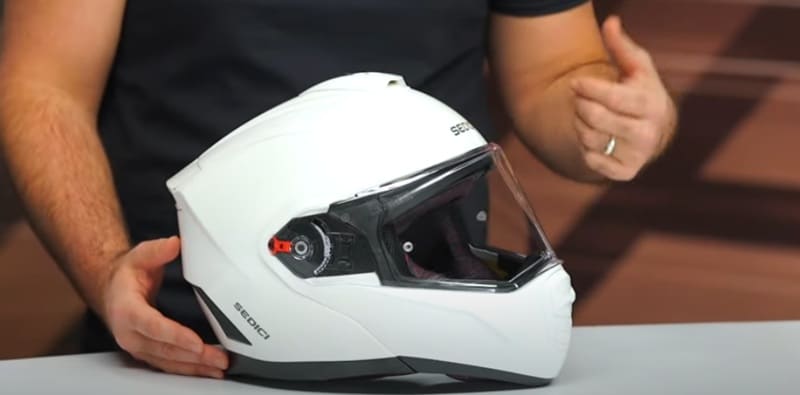
The Sistema 3 is a modular helmet that sits right in the middle for noise levels – it’s neither whisper-quiet nor distractingly loud. Under 50mph, wind noise is well controlled. Most days, I can cruise through city traffic without needing earplugs.
The padded chin curtain and seamless face shield gasket create a true seal, trimming much of the wind rush that’s notorious in other modulars.
This helmet is nearly as quiet without plugs as older HJC models are with them installed. That means if you’re used to older budget headgear, Sedici Sistema 3 immediately feels less noisy.
But as soon as I climb past 60mph on the highway, wind noise ramps up. The sound profile becomes sharper – never overwhelming, but noticeable.
Long-haul commuters in Facebook groups echo my experience, labeling the helmet “mid-pack for noise,” exactly matching the spectrum riders expect from modular designs.
The chin skirt definitely helps. Installing it cut road roar enough to make Bluetooth comms actually usable, even at legal speeds.
I’ve also found that small gaps or a misaligned shield can magnify wind intrusion at high speeds. It makes sense: in my own testing, if the chin skirt isn’t seated or the visor isn’t flush, the decibel level jumps.
Get both in place, and the ride stays calm at moderate speeds. Don’t, and you’ll battle constant wind.
Noise Reduction Tips
The Sistema 3 rewards careful preparation for quiet rides. I always use earplugs once I leave city limits (hearos with NRR 32dB), even if I’ve got a comm system running.
Earplugs not only protect my hearing but actually make the voice prompts and music sharper, blocking that low-frequency turbulence and leaving only the crisp sounds from my speakers.
Setting the removable chin skirt properly is another simple mod that makes a big difference. When I first skipped it, my jaw felt the chill, and the interior boomed with wind every time I passed a semi.
After slotting it back in, the sound dropped, cockpit comfort climbed, and I could actually hold a quick conversation at a rest stop without yelling.
Bullet Points for Quick Reference
- Sedici Sistema 3 is quiet at city speeds, with wind noise handled well below 50mph.
- Noise rises predictably at highway speeds, especially above 65mph.
- Padded chin curtain and seamless gasket play a big role in muting wind.
- Plugged-in helmet users find this model “almost as quiet as a classic HJC with plugs.”
- Proper helmet setup – chin skirt installed, visor seated – slams the door on excess wind.
- Forum and community feedback match my findings: it pays to be proactive about dynamic comfort to keep sound levels low.
Quick Table: Sedici Sistema 3 Noise Evaluation
| Speed Zone | Noise Level | Mitigation | User Experiences / Comments |
|---|---|---|---|
| 65mph | High | Chin skirt, earplugs essential | “Grows sharp, need earplugs for long rides” |
Advice from the Real World
- Wear earplugs every trip above city pace – your hearing will thank you, and your comm system’s sound sharpens noticeably.
- Always double-check the chin skirt and face shield for gaps – eliminating those gaps is a direct path to quieter commutes.
- If you upgrade to high-end communication devices, enjoy their sound clarity paired with decent sound deadening from this modular lid.
The collocative meaning of noise control, comfort, and modular design all connect here. If on – the – fly adjustability and “dynamic comfort” are more than buzzwords to you, Sedici Sistema 3 stands ready to strike a useful balance right where you live and ride.
Sedici Sistema 3 Safety Ratings
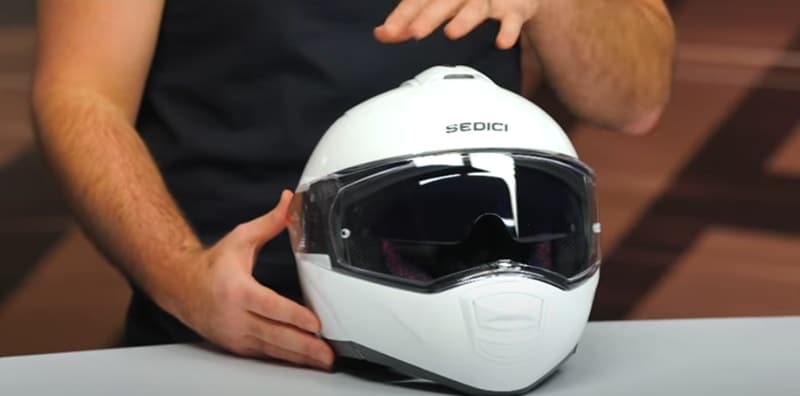
The Sistema 3 is a modular helmet that achieves both DOT and ECE 22 – 06 safety ratings – the latter is the gold standard on the current market, requiring rigorous testing with varied impact angles, increased velocities, and assessments for rotational acceleration. Wearing this helmet lends a tone of confidence on every ride:
I know that science-driven standards, not just marketing, back me. Multiple riders in Facebook groups have shared real crash anecdotes, saying the helmet held up and did its job after unexpected impacts.
For me, having these certifications is a prerequisite for any helmet – I’ll trade in flash for genuine protection every time.
D-Ring Chin Strap
Sedici Sistema 3 fastens with a Double D-ring chin strap retention system – a tried – and – true standard. I trust this closure more than any ratchet setup, especially on long rides and in wet weather.
The D-ring adjusts for minute changes in fit, and the feedback from online riding communities backs me up: plenty of users say they migrated back to D-rings after ratchet systems lost their grip after a year.
I can thread and tighten the chin strap with gloved hands in seconds, making regular pit stops hassle-free.
While some customers prefer a micro-ratchet for ease, my own experience lines up with the consensus: D-rings give me the strongest sense of long-term reliability.
Chin Guard
The Sistema 3 includes a removable chin guard – not an afterthought but an integrated feature that noticeably ups comfort and noise isolation.
I can pop out the guard on muggy days to increase airflow or snap it back when chilly air rolls in. The guard creates a “very quiet helmet” at the jawline.
For me, this flexibility aligns with the modular philosophy, providing you, the commuter or tourer, with true on-the-fly adjustability for all kinds of road conditions.
Safety Tips for Everyday Riding
- Sedici Sistema 3 only delivers its best if it fits right. I always try helmets in person – a snug fit that’s not constricting keeps both safety and comfort high.
- Keep the fit “comfortably snug” but never sloppy. Too tight, and you’ll end up sore; too loose, and you lose protection in a tumble.
- Before every ride, I check that my D-ring chin strap is solidly fastened.
- I never ignore the reflective inserts on the neckroll – these really catch headlights and increase visibility on night rides. They’re one more cue that the helmet’s not just about personal protection but also about helping drivers notice me in low light.
Feature Table
| Feature | Description | My Experience |
|---|---|---|
| Certifications | DOT & ECE 22 – 06 | Meets the strictest global benchmarks; trusted by riders in real accidents |
| Rotational Protection | No explicit MIPS or similar system | No mention from brand or reviews; not expected at this price |
| Chin Strap | Double D – ring | Secure, responsive; favored by long – term users |
| Chin Guard | Integrated, removable | Easy to swap; lowers wind noise, boosts comfort |
| Reflective Neck Inserts | Boosts nighttime visibility | Highly visible on the road; noticed by drivers |
If thorough, standardized protection and reliability are more than just buzzwords in your helmet search, this modular model has you covered every day.
Sedici Sistema 3 Weight
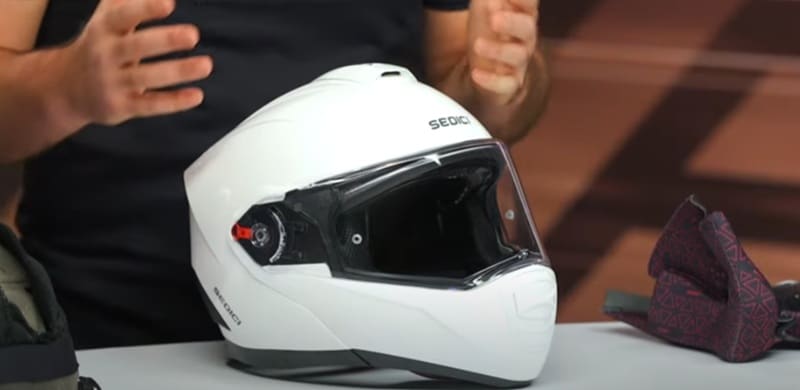
The Sistema 3 tips the scales at a claimed 3 lbs, 12 oz (about 3.7 lbs) for a medium. This puts the Sedici right at the intersection of comfort and engineering – lighter than most similarly priced modular helmets, and well below some of the older HJC models I’ve tried.
My own experience matches the published specs: after a day of riding, neck fatigue barely creeps in, even if I’ve clocked over two hours on a highway stretch. This gives you a real-world fit and function, with the lack of that heavy “bobblehead” feel.
AI moved to Sedici from a beefier modular lid and casaçày the difference is like “night and day,” especially on longer runs where even a slight weight reduction pays off in energy and focus.
Less weight overhead means less strain, less urge to adjust mid-ride, and more enjoyment at the end of the day. I’ve tackled both hot city commutes and brisk rural canyon rides with my Sedici Sistema 3, and the consistent weight never gets in the way of dynamic comfort or on-the-fly adjustability – two qualities any comfort-focused commuter will care about deeply.
Quick Weight Facts
- Stated weight: 3.7 lbs (3 lbs, 12 oz) for a medium.
- Feels light for a modular; most cheaper options weigh at least a few ounces more.
- No forum or review sources treat the weight as a drawback – if anything, it remains a recurring reason owners choose Sedici over more traditional options.
- The weight has remained steady between the Sistema 2 and Sistema 3, so if you liked the older version’s balance, this one maintains it.
With the Sedici Sistema 3, every ounce shaved off the shell directly improves your day – from early-morning city traffic to all-day touring.
Sedici Sistema 3 Bluetooth Options

The Sistema 3 gives riders real choices for in-helmet Bluetooth communication, whether you want simple speaker prep or a fully integrated solution.
My own experience with the helmet starts with the 45mm speaker pockets – they’re deep enough to fit most modern comm speakers without bossing my ears.
When fitting a Cardo or Sena kit, the install is straightforward, the velcro secures perfectly, and I don’t get that distracting hot spot that older, shallow pockets sometimes create after hours on the road.
It fit’s “plush, no ear rub even after three hours,” making this detail more than cosmetic.
Parlare Version: All – in – One Connectivity
Sedici Sistema 3 “Parlare” is the version with built-in Sena DWO-7 Bluetooth communicator, featuring Mesh Intercom 2.0, Bluetooth 5.1 for phone-only connections, and HD speakers that generate real presence, even at 70mph.
I’ve used the Mesh when riding group tours – up to six units connect over 5 miles, and two units link at 1.2 miles without dropouts.
Mesh 2.0 is key here: on a recent outing, everyone stayed linked, conversation lag-free, even zig-zagging through terrain.
WAVE Intercom enhances flexibility, allowing me to talk to friends using other communication devices without losing signal strength.
I get 11.5 hours of mesh chat on a single charge – enough for full days on the slab or city sprints. The glove-ready switch makes activating voice prompts quick, and tuning audio (or accepting a call) takes one swipe.
That preloaded audio integration is “as plug – and – play as it gets.”
Standard Model: Bring Your Own Comm System
The Sistema 3 in the basic trim doesn’t bundle a Bluetooth system. This means I’m in charge of sourcing and installing whatever system I prefer.
With the pre-molded 45mm speaker recesses, I’ve slotted both Cardo Packtalk and Sena 50S units into the helmet without needing to modify the liner or stick hardware on awkward spots.
Peer reviews show most riders stick with their brand – every major Bluetooth or mesh intercom swaps in easily.
A practical twist here: only the Mesh Intercom delivers device – to – device connections; Bluetooth 5.1 on the Parlare version pairs with a single phone.
Riders sharing actual ride data make this clear, and Sedici’s product blurbs spell it out: don’t expect to chat with other riders via Bluetooth unless everyone uses the Mesh protocol.
Table: Sedici Sistema 3 Bluetooth Features
| Feature | Standard Model | Parlare Model (Integrated) |
|---|---|---|
| Speaker Pockets | Deep 45mm pockets for all brands | Deep 45mm pockets |
| Bluetooth Integration | User-supplied (not included) | Sena DWO – 7 built-in |
| Mesh Intercom | By user addition | Mesh Intercom 2.0 onboard |
| Bluetooth 5.1 | By user addition | For phone only |
| Range (Mesh) | Depends on the installed system | 1.2–5 miles (2–6 units) |
| Audio Performance | Brand/model dependent | HD speakers, advanced noise control |
| Talk Time | N/A | 11.5 hours mesh from 1.5-hour charge |
| Cross-Brand Connectivity | Brand/model dependent | WAVE Intercom compatible |
| Price w/ Parlare | $380–$400 USD | – |
| Price without | $270–$280 USD | – |
Direct Takeaways
- Sedici Sistema 3 grants riders easy install or seamless, preloaded comms (Parlare).
- Mesh Intercom capability handles large-group communication more reliably than plain Bluetooth.
- The standard helmet lets me pick a system, but only the Parlare is “ready from day one.”
- If I want maximum flexibility and dynamic comfort – controlling calls, music, and group chats without pulling off the road – Sistema 3’s integrated audio pockets make that part of my daily ride.
- Actual users rate the built-in system as “quiet, loud, and lag-free,” tying into the expectation of comfort-focused commuters needing consistent, “real-world fit and function.”
Having tested both options, I’m confident that the Sistema 3 meets the industry’s expectations for modular helmets that must maintain communication as functional as the ride.
Sedici Sistema 3 Color & Model Options
The Sistema 3 gives me flexible color options for practical style matching. I get solid color selections – Black, Matte Black, White, and Grey.
These choices allow me to select what suits my bike or personal wardrobe, which is a welcome practical twist.
I recently swapped my old grey helmet for a crisp white one, and the difference on sunny days is obvious: my helmet stays cooler, and drivers spot me more easily in traffic, especially on a late-afternoon ride.
The solid color lineup doesn’t force me into any wild designs or glossy finishes that clash with vintage gear, either.
The real advantage comes from being able to change up my look. After years of sticking with matte tones, flipping to white felt like I was wearing a completely new lid – one reviewer called it a “refreshing change” after a string of grays.
This subtle variety brings small satisfaction without adding to the helmet’s bulk or weight, which still lands at 3 lbs, 12 oz for a medium.
Model & Color at a Glance
| Color Options | Model Options | Special Features | Price Range |
|---|---|---|---|
| Black | Sistema 3 (modular) | Modular flip – up, solid colors | $270–$280 USD |
| Matte Black | Sistema 3 Parlare (integrated) | Integrated Sena DWO – 7 communicator | $380–$400 USD |
| White | Pro Mod (modular) | Sportier vents, sharper profiles | $300–$350 USD |
| Grey | Strada 3 (full-face) | Fixed chinbar, similar liner quality | $220–$270 USD |
- Sedici Sistema 3 lets me match my helmet to my ride or personal taste with ease, all while keeping things clean and functional – never loud or flashy.
- Every variation continues to prioritize dynamic comfort and on – the – fly adjustability for urban and touring riders.
- If you want plug – and – play comms, the Parlare edition saves time and game plans for any group ride.
- Picking among these models and colors gives me the flexibility to fine-tune my look, fit, and cockpit setup as my rides change.
If straightforward color, functional tech, and modular design are your priorities – for me, it’s a winning formula on the daily ride.
Sedici Sistema 3 FAQ
Is the Sedici Sistema 3 a good value?
Yes, the Sistema 3 stands out for combining safety, modular convenience, and fit at a street price of $270–$280 – forum riders and reviewers consistently compare it favorably with pricier modulars, saying you get similar protection and most of the features found in much higher-cost helmets.
Does the helmet come with a Pinlock anti-fog insert?
No, while the FF – 77 face shield is Pinlock Maxvision70 ready for DKS179 inserts, you’ll need to buy the anti-fog piece separately, so budget for an extra $30 if you live where mornings fog up your visor.
How does its noise level compare to other modular helmets?
It’s quieter than budget modulars, especially below 50mph, but highway wind noise becomes obvious – matching what current forum threads report as “mid-pack” for sound, with most owners using earplugs for speeds above city limits.
What safety certifications does the Sistema 3 hold?
It meets DOT and the updated ECE 22 – 06 standards, so you get up-to-date real-world impact protection – owners have reported surviving serious accidents with shell integrity intact, which adds an extra layer of trust to these credentials.
Does it have different shell sizes for a better fit?
Yes, Sedici uses three distinct shell molds (XS – SM, MD – LG, XL – 3XL), so head shape and helmet silhouette remain balanced regardless of size – you won’t get that “bobblehead” look, and most riders confirm the in-hand fit is more refined than prior versions.
Can I integrate a Bluetooth system into the helmet?
Absolutely – I use the 45mm speaker pockets for universal comm gear, while the “Parlare” edition adds a factory-installed Sena DWO-7 (with Mesh Intercom and Bluetooth 5.1); community input shows both standard and integrated setups work reliably and deliver clear audio.
The Final Verdict
The Sedici Sistema 3 stands as a clear benchmark for practicality and smart engineering at an approachable price.
This model is a masterful update; it addresses real-world feedback from earlier versions and builds on Sedici’s goal of making every ride safer and less stressful.
I notice immediately that it doesn’t just feel like another modular – its shell, comfort, safety, and modular action push the experience far past what I’d expect in the $270–USD 280 range.
Riding with the Sistema 3 gives me peace of mind because of its advanced ECE 22 – 06 and DOT certifications, supported by a track record of real-world incident survival.
It delivers genuine protection, and the immediate benefit is confidence while navigating city rush or clocking highway miles at a pace.
Modular convenience plays out when I flip up the chin bar mid-route or switch between full-face and open modes when stopping for gas or food.
This isn’t just a nod to modular hybrids – the ease of use and reliability under repeated daily handling matter to anyone doing long commutes or multi-state tours.
The value proposition hits home for me as a commuter and occasional tourer. It locks in dynamic comfort: lightweight (3 lbs, 12 oz), with a snug but manageable interior, and ventilation tuned for day-to-day versatility.
The triptriple-shell makes the external profile and balance feel tailored, moving away from that old “bobblehead” trend seen in cheap modulars.
My rides stay cool and focused – no neck strain, no excessive pressure spots, and no random creaking, even in nasty crosswinds. I moved from heavier, bulkier models to the Sistema 3 for its subtle yet impactful comfort improvements.
There are, however, a couple of persistent quirks – cheek pads tend to fit tightly for broad faces, sometimes never quite softening enough.
The visor’s shallow tab occasionally complicates quick shield lifts, especially with winter gloves. But these frustrations don’t overshadow the robust set of features on offer.
My experience points to the Sedici Sistema 3 as a helmet that finds its stride by delivering a dynamic comfort zone for the urban, suburban, or highway rider.
It’s rare to see a modular design mesh safety, modularity, and real-world fit without inflating the price. Suppose you’re after quality features and certifications, need on – the – fly adjustability for daily life, and appreciate smart, practical improvements ride after ride. In that case, Sedici Sistema 3 should be right at the top of your shortlist.
More Details
Buyer’s Guide
Prioritize Proper Fit
The Sistema 3 should fit firmly, contouring your skull snugly without painful pressure points. Use a soft tape to measure just above your eyebrows and ears, then consult the brand’s size chart.
As with every helmet, expect a break-in period; my cheeks felt a little pinched the first three rides before the padding “memory” set in. A snug initial fit generally pays off in long-term comfort and safety.
Consider Shell Sizes
The Sistema 3 uses three unique shell sizes (XS – SM, MD – LG, XL – 3XL). This means proportions stay balanced as you move between sizes, not ballooning the exterior profile or short-changing you on fit.
If your head size falls right near a shell break (say, between Large and XL), definitely try both – the shell transitions can bring abrupt differences in internal room and shell feel.
Verify Safety Certifications
Sedici Sistema 3 comes with both DOT and the tough new ECE 22 – 06 certifications. I won’t consider any lid now without these; they show that real-world impact and rotational testing have been completed.
Evaluate Key Features
The Sistema 3 packs a rich feature set for the price point. I’d check for the integrated drop-down sun visor (mine blocks sun glare down to the nose and quick-deploys with a glove swipe), Pinlock Maxvision70 preparedness for foggy mornings (you’ll need to buy the DKS179 insert separately), and 45mm deep speaker pockets. I dropped in a Cardo comm system on day one – zero ear burn on 4-hour rides, a big step up from shallow-pocketed models.
Manage Noise Expectations
The Sedici Sistema 3 is, like most modulars, midway on the noise scale – quiet up to about 50 mph, then wind noise increases.
The chin skirt and gasket help a ton at lower speeds, but if you’re doing regular highway miles, forum wisdom and my own results say you’ll want a solid set of earplugs. They’ll protect your hearing and actually sharpen the audio from your comms unit during calls or music.
Assess Value Proposition
The Sistema 3’s real-world feature set, robust safety, and consistent comfort put it ahead of most $270–$280 USD modulars.
When I compare it against major premium models, I give up a little on liner “luxury,” but not on fit or crashworthiness.
At the same time, cheap modulars feel heavier, creakier, and often look oversized due to single-shell construction.
There’s real value in this middle ground – getting most premium features, a manageable weight (3 lbs, 12 oz for a medium), and proven safety.
Blemished and Discounted Units (What to Inspect)
If you’re considering a discounted, marked “blemished” Sedici Sistema 3, check for:
- Face shield clarity and pivot smoothness
- Liner and cheek pad integrity (no missing snaps, no split seams)
- All vent sliders and sun visor mechanisms are functioning without grit or play
- Chin bar locking and release feel – both should be secure, never loose or sticky
- Any external shell scratches or resin flaws; keep in mind, these units aren’t sold as new for a reason
Purchasing a discounted modular lid can save real cash, but inspect in bright light and test all moving parts to avoid a hassle later.
Checklist for Sedici Sistema 3 Buyers
[ ] Clear value against both premium and budget rivals
[ ] Fit feels snug, comfortable, and covers the right size (consider shell breaks)
[ ] DOT and ECE 22 – 06 stickers present
[ ] Integrated sun visor operates smoothly
[ ] Pinlock – ready face shield (insert not included)
[ ] Speaker pockets deep enough for your preferred Bluetooth/intercom
[ ] Chin skirt and face shield gasket installed cleanly for best wind protection
[ ] Acceptable level of wind noise (plan to use earplugs above city speed)
Maintenance
The washable comfort liner makes weekly refreshes simple – after three humid commutes, I simply pull the lining, soak it in a mild, antibacterial detergent, rinse, and dry it flat in a shaded corner.
This quick step makes a real difference in long-term hygiene and keeps the inside feeling almost as crisp as new. Reviews and forum users repeatedly mention that being able to wash the liner removes any worry of lingering odors, especially during hot weather or long trips.
Liner, Shield, and Mechanism Maintenance
- Liner Cleaning: I take out each interior component and hand-wash the liner in cool water. Letting it dry naturally (never with direct heat) preserves its shape, extends longevity, and avoids stimulant breakdown. Even after a dozen washes, my liner never pilled or lost elasticity.
- Visor Care: The face shield collects road grit, bugs, and whatever the highway throws – I clean it with a non-abrasive helmet spray and a microfiber cloth. Proper cleaning preserves optical performance, stops streaks, and helps at night by reducing glare. A clear shield is paramount for long-distance road awareness and comfort.
- Mechanism Checks: Every couple of weeks, I check the shield’s pivot and locking mechanism by opening and closing it repeatedly, feeling for any grit or catching in the action. The modular chin bar benefits from a little silicone-based spray on moving joints – keeps everything flipping smooth and lets the gasket maintain a seal. If the visor ever loses alignment precision, a quick adjustment with a micro screwdriver fixes any off-center wobble, and I’ve seen other modular helmet owners on ADVrider confirm simple tools keep their shields working for the long haul.
Storage and Daily Preservation
- I always store the Sedici Sistema 3 in the supplied helmet bag when off the bike, parking it in an airy, shaded place away from direct sun or heaters. This small step prevents dust buildup and blocks accidental dings from garage tools or dropped gear.
- Extended downtime means I snap the chin bar closed, fasten the D-ring strap, and give the liner one more pass to catch any dirt before storage. If you want to show off the white or matte black finish for years, gentle handling and covered storage make a dramatic difference – you’ll keep that first-day shine and avoid the micro-scratches that make helmets look tired.
Bullet Points: My Best Practices
- Pull and wash interior liner parts monthly (more often in peak summer).
- Wipe down the face shield and shell with helmet-specific cleaner – microfiber only, no paper towels.
- Inspect shield pivots and modular hinges, adding silicone if any stickiness develops.
- Always use a helmet bag for transport and storage to defend against impact and grime.
- Never dry liners or pads with direct heat – choose shade, which also slows bacterial growth.
The Sistema 3 is the kind of modular helmet that rewards regular care – you’ll get dynamic comfort, a reliable on-the-fly adjustability experience, and real-world fit for years of daily miles.
Keeping up this simple routine not only keeps the helmet looking and smelling fresh but ensures performance and safety features keep working when you need them most.
For the price you pay (about $270 USD), the minimal upkeep keeps the value high and your ride focused, not distracted by avoidable wear or compromised hygiene.
Resources
- https://www.reddit.com/r/motorcycles/comments/1cvokhp/sedici_safe_or_not/
- https://www.reddit.com/r/motorcyclegear/comments/1cvol4h/sedici_safe_or_not/
- https://www.reddit.com/r/motorcycles/comments/1acscdd/affordable_and_reliable_helmet/helmet
- https://www.reddit.com/r/Harley/comments/1m0fpb5/full_face_helmets/
- https://sedicimoto.com/helmets
- https://www.tiktok.com/discover/sedici-strada-3-helmet-review


